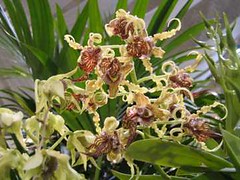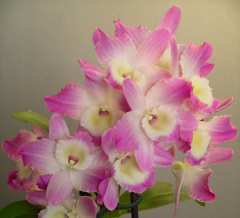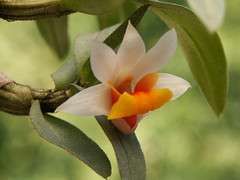Dendrobium orchids comprise the largest and most diverse “catch-all” orchid genus. It almost seems that whenever taxonomists don’t know where an orchid belongs, they classify it as Dendrobium. But of course, there is at least some logic to the organization. The over 1,200 Dendrobium species are native to the tropics of Asia and The Pacific. Papua New Guinea alone has more than 500 species. Usually you would find Dendrobium growing in the tops of trees. In fact, the name Dendrobium is Greek for “life in a tree.”
Dendrobium are so diverse that you could find them growing in tropical lowlands and all the way to an altitude of 10,000 feet (3,000 meters). You could also find them in humid, swampy ground or desert-like environments. As you can imagine, that diversity does not make it easy for me to tell you exactly how to grow your Dendrobium. So you’re out of luck.
Just kidding – I’ll try. Some species like it hot; some like it cool. Some species are deciduous and require a break from watering, but others are evergreen. However, there are two commonalities to all Dendrobium species. They all like to live in tiny pots that can barely accommodate their short, shallow root systems. Bigger pots would just make the medium stay wet for too long time and promote rotting. A tip for you is to put the small pot inside a bigger and heavier pot to avoid tipping of the plant. Besides wanting to feel snug and secure, Dendrobium also likes to be in a bright environment. I am not saying that you should toast your Dendrobium in the mid-day desert sun, but you should put it where it can receive bright light most of the day. If you are growing indoors, put it by a south-facing window (north-facing if you live in the southern hemisphere). If your Dendrobium does not bloom, the likely answer is to increase the light.
Dendrobium Hybrids
Your best bet to grow Dendrobium orchids is to start with a hybrid. Because hybrids combine two parent plants that
likely have different characteristics and requirements, the child plant will likely be able to thrive in a wider range of environments, meaning it’s easier to grow. The kinds you often see for sale are the soft cane, a.k.a. nobile type, and the Phalaenopsis type.
Nobile Type
Nobile hybrids are deciduous, meaning that they are dormant and lose some or all of their leaves in the winter. Generally speaking, this dormancy last about two to three months after a cane has matured in later autumn. It is important that you don’t water or feed your plant during this time. At most, just mist it once a month if you see the canes shrivel too much. I know it is hard to not baby your orchid for months, but this is the only way you can make them happy. When new growth starts to appear, you can resume watering gradually.
The most popular nobile type is Yamamoto Dendrobium hybrids. These stunners can easily have 40 or 50 flowers on one plant and the flowers can last up to three weeks. They come in many different colors, with the most popular ones being pink, yellow and white. Growers have the requirements of these plants down to a science, and can time the flowering to a specific holiday. You can also reliably bloom your Yamamoto Dendrobium hybrid at home. Your plants will love you if you provide them plenty of light, air circulation and a drop in temperature to the low 50s°F (10s°C) for a month. Just fertilize a little after flowering, but before the new growths start. Too much fertilizer will make the plant grow off-shoots instead of flowers. And don’t even think about the slow release fertilizers—these just provide an excessive volume and concentration of fertilizer, which will burn the roots.
Phalaenopsis Type
The Phalaenopsis type of Dendrobium orchid is so named because the flowers look like another genus—Phalaenopsis. With up to 20 flowers at a time, these beautiful orchids certainly give you all the bangs for the bucks. To make sure they are comfortable, you should allow the potting medium to be dry before you water again, especially in the winter months; otherwise, their roots will rot and die. Keep them in bright light, warm temperature (65 to 82 °F/18 to 24 °C), high humidity (60% to 70%) and strong air movement, and they will reward you with a spectacular display of flowers. Some of the hybrids might flower more than once a year.
Dendrobium Species
Dendrobium orchid species are not off-limits for beginners. Some of them are easy to care for and the flowers are as
showy and gorgeous as those of hybrids. Among my favorites is Dendrobium loddigesii. They are cute little plants (up to 8 inches/20 centimeters high) with two-inch-wide (five centimeter) flowers. Like all other Dendrobium, these Chinese beauties require bright light. Even though they are supposed to be fragrant, I haven’t detected any smell from mine (maybe it’s my nose). Grow them at 45 to 60 °F (7 to 15 °C) and give them a dry rest in the winter after some leaves fall off, and they will give you flowers that last 6 weeks or more.
Another favorite of mine is the easy-to-please Dendrobium kingianum. These not-so-little guys (18 inches/46 centimeters) have one-inch (2.5 centimeter) flowers and are naturally found in Australia on rocks. You don’t have to remember to withhold water because they are evergreen and require no water rest period. Put them in an environment with intermediate temperature (55 to 60 °F/13 to 16 °C) in well-drained potting mix, and they will give you up to 15 fragrant flowers.
I also recommend an uncommon yet fairly easy species—Dendrobium bellatulum.
As the name “bellatulum” implies, this little plant is a beauty. They are native to India, Burma, Thailand, China, Laos and Vietnam. The long-lived flowers appear in late winter or early spring and have bright orange lips and white petals. If you live in a humid environment, you can mount the orchid on slab of wood; otherwise you can grow it in a well-drained mix in a clay pot. Remember to keep it cool and dry in the winter.
Happy growing!






